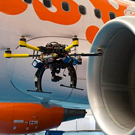Engineer Smarter Regulation In The Digital Age
Dr. John Bartlit
New Mexico Citizens
for Clean Air & Water
Column of December 3, 2017, Los Alamos Monitor
 Smart tools are good multitaskers that save mistakes, time and money. Smart tools employ thinking chips to inspect, measure, analyze, verify and report faster than any one of these tasks was done before. Industry finds more of these tools are worth using to make their plant operations more reliable. Output and quality both get better.
Smart tools are good multitaskers that save mistakes, time and money. Smart tools employ thinking chips to inspect, measure, analyze, verify and report faster than any one of these tasks was done before. Industry finds more of these tools are worth using to make their plant operations more reliable. Output and quality both get better. The same industries have complained long and strongly that regulations need to be simpler, more useful and less costly. That problem is debated piecemeal in the news. “Piecemeal,” though, can easily miss the nitty-gritty.
Regulation begins with proper debating, then deciding what needs regulation and how much regulation to have. All this work is the first half of the task. The second half of regulating is perpetual checking to see whether the resulting rules are followed.
The persistent expenses to verify compliance are low-level news. Money is sometimes required to comply with a rule, as to reduce a plant’s emissions. Yet, more than half the total costs of regulating easily mount up from verifying constant compliance once rules are set.
Cures are found in the same kinds of smart tools that companies use for swift, sure checking in their plants. Methods that monitor plant operations better will do the same in regulating. The skill sets for both are the same: inspect, measure, analyze, verify and report faster than before. Money saved is money saved.
So, why don’t the new methods already play as large a part in regulating as in plants? Dig into the nitty-gritty. Mutual distrust is a contagion in our land. We lose sight of where gridlock has intruded far beyond Congress.
Over time, regulations have shown mixed efficiency and mounting costs. Debates are now less about regulating better and dwell more on what must be banned because regulations failed. The list of things that people suspect should be banned grows longer—offshore drilling, nuclear plants, fracking, chemicals of many kinds and new oil pipelines, to name some big ones. Political parties take stands on whether to ban or not to ban.
No one argues head on against making regulations better, faster and cheaper. Still, fears sneak in. Industry gives higher priority to cheaper regulation than to better and faster. Environmental lobbies, on the other hand, give higher priority to better and faster regulation than to cheaper.
Each side fears its opponents will win what they want the most and their own side will gain too little. Both sides have grim anecdotes they tell. Each side blames a different party for prior treacheries. Mutual distrust and gridlock fill the air. In this climate, the drive for better prospects has been slow to grow. Yet that urge still grows. A few industries have come to realize that regulatory stalemate is not in their best interest. The airlines, for one, have worked for years to develop and demonstrate the regulatory benefits of smart tools.
“Regulation” for airlines consumes large sums of time and money inspecting aircraft, from 100-hour inspections to annual inspections, plus special inspections. At last summer’s InterDrone 2017, Intel Corporation announced its new line of drone-based tools that inspect aircraft efficiently. Before these measures have regulatory value, proper data are required to prove the smart tools reliably meet the safety and legal purposes of inspecting. No small task, that.
The means of better regulating in the Digital Age could begin a broad new discipline at leading technical schools such as my alma mater, Purdue University. A fitting name would be regulatory engineering. The field has breadth and depth to appeal to students and entrepreneurs alike.
A final thought: The engineering work on more useful, less costly regulation, as outlined in this column, has potential to cut gridlock itself. Any progress made on that front would have incalculable benefits to the nation.